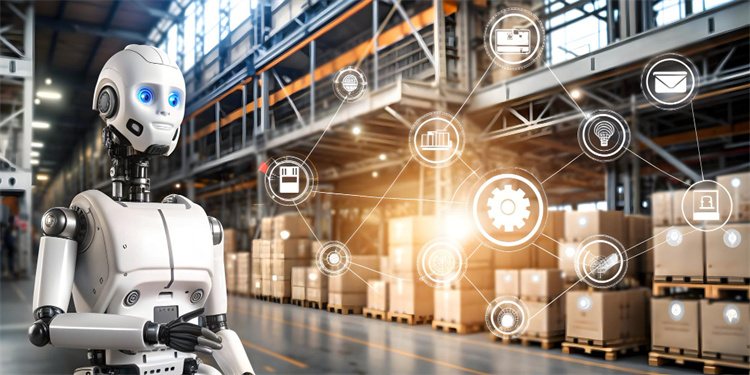Data-Driven Supply Chains: Europe's Tech Leap

Europe's supply chains face significant challenges today. Companies are increasingly near-shoring and diversifying their sourcing strategies. Over half of European firms are redesigning their supply chains for regional models. This shift highlights the urgent need for technological advancements. Supply Chain Visibility situation in Europe is crucial as firms strive to enhance efficiency and sustainability. Advanced technologies like AI and IoT are pivotal in this transformation, streamlining operations and reducing costs. As companies embrace these innovations, they aim to overcome logistical hurdles and improve overall performance.
Supply Chain Visibility situation in Europe
Current Challenges in European Supply Chains
European supply chains face numerous challenges today. Economic and operational hurdles significantly impact their efficiency and reliability. Companies encounter rising costs due to inflation and labor shortages. These factors increase operational expenses and complicate logistics management. Additionally, geopolitical tensions, such as Russia's invasion of Ukraine, disrupt supply routes and create uncertainty in the market.
Economic and Operational Challenges
Economic challenges in Europe stem from various factors. High inflation rates lead to increased costs for raw materials and transportation. Labor shortages further exacerbate these issues, making it difficult for companies to maintain smooth operations. The manufacturing sector experiences a recession, which affects production schedules and delivery timelines. Businesses must adapt to these economic pressures to ensure continuity and competitiveness.
Environmental and Regulatory Pressures
Environmental and regulatory pressures also play a crucial role in shaping supply chain strategies. New sustainability regulations require companies to adopt eco-friendly practices. This shift towards resilience and sustainability demands significant investments in technology and infrastructure. The European Union's focus on reducing carbon emissions and promoting green initiatives adds another layer of complexity to supply chain management. Companies must navigate these regulations while maintaining efficiency and profitability.
"Supply chain issues in Europe are partly resolved post-COVID, but challenges remain due to Russia's invasion of Ukraine, cost increases, labor shortages, and product shortages." - European supply chain update - August 2023
Technological Advancements in Supply Chains

Internet of Things (IoT)
IoT Tags for Real-Time Tracking
The Internet of Things (IoT) revolutionizes supply chain management by providing real-time tracking capabilities. Companies use IoT tags to monitor the movement of goods throughout the supply chain. These tags offer precise location data, enabling businesses to track shipments and reduce delays. This technology enhances visibility, allowing managers to respond swiftly to disruptions.
Enhancing Inventory Management
IoT also plays a crucial role in inventory management. Sensors and connected devices provide accurate data on stock levels. This information helps companies automate replenishment processes and avoid overstocking or stockouts. By optimizing inventory, businesses can reduce waste and improve efficiency.
Artificial Intelligence (AI)
Predictive Analytics for Demand Forecasting
Artificial Intelligence (AI) transforms demand forecasting through predictive analytics. AI algorithms analyze historical data to predict future demand patterns. This insight allows companies to adjust production schedules and align resources with market needs. Improved forecasting leads to better customer satisfaction and reduced operational costs.
AI-Driven Automation
AI-driven automation streamlines supply chain operations. Robotics and machine learning technologies automate repetitive tasks, increasing productivity. Automated systems handle tasks such as sorting, packing, and quality control. This reduces human error and enhances overall efficiency.
Blockchain Technology
Ensuring Transparency and Traceability
Blockchain technology ensures transparency and traceability in supply chains. It creates a secure and immutable ledger of transactions. Companies can track products from origin to destination, ensuring authenticity and compliance. This transparency builds trust with consumers and partners.
Securing Transactions and Data
Blockchain also secures transactions and data within the supply chain. It protects sensitive information from unauthorized access and fraud. By using blockchain, companies enhance data integrity and reduce the risk of cyber threats. This security fosters confidence in digital transactions and collaborations.
"The integration of AI, IoT, and blockchain can address challenges like limited visibility and inefficient inventory management, making supply chains more efficient and resilient." - Integrating Blockchain, IoT, and AI in Supply Chain Management
Applications of Technology in Supply Chains
Case Studies and Examples
Use of Autonomous Drones
Autonomous drones have become a game-changer in supply chain logistics. Companies deploy these drones for various tasks, such as inventory checks and delivery operations. Autonomous drones Sustainability Through Technology in Logistics highlights how drones reduce carbon footprints by minimizing the need for traditional transportation methods. They optimize operations by providing real-time data and reducing waste. Drones can access hard-to-reach areas, ensuring timely deliveries and enhancing overall efficiency.
Inventory Management: Drones conduct aerial surveys of warehouses, providing accurate stock levels without human intervention.
Delivery Operations: They transport goods over short distances, bypassing traffic and reducing delivery times.
Environmental Impact: By using electric power, drones contribute to lower emissions compared to conventional vehicles.
"Drones and IoT in Logistics are pivotal in reducing carbon footprint, optimizing operations, and reducing waste." - Sustainability Through Technology in Logistics
Smart Warehousing Solutions
Smart warehousing solutions leverage advanced technologies to transform traditional storage facilities. These solutions integrate AI-driven automation, IoT devices, and robotics to enhance efficiency. Smart Logistics and Supply Chain Automation emphasizes the role of AI in increasing efficiency and improving inventory management. Automated systems streamline processes, reducing human error and operational costs.
AI Integration: AI algorithms predict demand patterns, optimizing stock levels and reducing excess inventory.
IoT Devices: Sensors monitor environmental conditions, ensuring optimal storage for sensitive goods.
Robotics: Automated guided vehicles (AGVs) transport items within warehouses, speeding up order fulfillment.
"AI-driven automation in warehouses and supply chains leads to increased efficiency, reduced waste, and improved inventory management." - Smart Logistics and Supply Chain Automation
Smart warehousing not only boosts productivity but also supports environmental goals. By utilizing resources efficiently, these solutions contribute to a greener supply chain. As technology continues to evolve, the potential for further advancements in supply chain applications remains vast.
Impact on the Logistics Industry

Improvements in Sustainability
Reducing Carbon Footprint
The logistics industry in Europe is making significant strides in reducing its carbon footprint. Companies are increasingly adopting electric vehicles and smart technologies to minimize environmental impact. These innovations not only cut emissions but also enhance operational efficiency. By integrating electric vehicles into their fleets, logistics providers reduce reliance on fossil fuels. This shift contributes to a cleaner environment and aligns with the European Union's sustainability goals.
"The logistics industry is transforming through digitalization and green practices. Innovations like electric vehicles and smart tech reduce environmental impact and increase efficiency."
Energy-Efficient Operations
Energy-efficient operations have become a priority for logistics companies aiming to achieve sustainability. Advanced technologies such as AI and IoT play a crucial role in optimizing energy consumption. AI-driven systems analyze data to improve route planning and reduce fuel usage. IoT devices monitor vehicle performance, ensuring optimal energy use. These technologies help logistics firms achieve energy efficiency while maintaining high service levels.
Enhancements in Productivity
Streamlined Processes
Technological advancements streamline processes within the logistics industry, leading to increased productivity. Automation and digital platforms simplify complex tasks, reducing the need for manual intervention. Automated systems handle sorting, packing, and inventory management, minimizing errors and speeding up operations. This streamlining of processes allows companies to focus on strategic activities, enhancing overall productivity.
"Smart logistics and transport will also be accelerated with the continued ramp-up of AI, IoT, data analytics and cloud across many use cases – improving traditional route optimization and applying machine learning, predictive and sensing capabilities."
Cost Reductions
Cost reductions are a direct benefit of enhanced productivity in logistics. By leveraging technology, companies can lower operational expenses and improve profitability. Automation reduces labor costs by minimizing the need for manual labor. Digital platforms optimize resource allocation, ensuring efficient use of assets. These cost-saving measures enable logistics firms to offer competitive pricing and improve their market position.
"Automation and digital platforms improve supply chain sustainability and cost-effectiveness, promising a sustainable, tech-driven future."
The Supply Chain Visibility situation in Europe continues to evolve as companies embrace these technological advancements. By focusing on sustainability and productivity, the logistics industry is poised for a transformative future.
Future Prospects and Expert Insights
Importance of Collaboration and Transparency
Building Stronger Partnerships
Companies in Europe recognize the need for stronger partnerships in supply chains. By collaborating with suppliers and logistics providers, they enhance efficiency and resilience. These partnerships foster trust and streamline operations, ensuring smoother processes across the board. Businesses that invest in building these relationships often see improved performance and reduced risks.
Sharing Data Across Networks
Sharing data across networks plays a crucial role in modern supply chains. Companies leverage technology to facilitate seamless data exchange, enhancing visibility and decision-making. This transparency allows for real-time monitoring and quick responses to disruptions. As a result, businesses can better align their strategies with market demands and regulatory requirements.
KPMG Supply Chain Expert: "The lack of visibility across the layered tiers of a supply chain has major implications for organizations. Sharing data is essential for meeting regulatory requirements and mitigating risks."
Forward-Looking Perspectives
Emerging Trends and Innovations
Emerging trends in supply chain technology continue to reshape the industry. Innovations such as AI, IoT, and blockchain drive efficiency and sustainability. Companies adopt these technologies to optimize operations and reduce costs. The focus on digital transformation ensures that European supply chains remain competitive in a global market.
Long-Term Benefits for Europe
The long-term benefits of these advancements are significant for Europe. Enhanced supply chain visibility leads to better resource management and environmental sustainability. Companies that embrace these changes position themselves for growth and success. By prioritizing innovation and collaboration, Europe can achieve a more resilient and efficient supply chain network.
"With the continued focus on resilience and ESG, the pressure on supply chain planning is increasing. Companies must adapt to meet the demands of a complex world." - KPMG Supply Chain Expert
Technology holds transformative potential for supply chains. It enhances efficiency, sustainability, and visibility. Industry leaders emphasize the importance of embracing digital solutions. They note that AI and IoT provide real-time tracking and analysis, which accelerates supply chain optimization. This shift is crucial for meeting consumer demands and improving operations. As companies continue to innovate, collaboration remains key. Sharing data across networks fosters transparency and resilience. The Supply Chain Visibility situation in Europe exemplifies this progress. By leveraging technology, Europe can achieve a more efficient and sustainable logistics industry.
See Also
Unveiling Big Data's Influence on Supply Chain Enhancement
Investigating Supply Chain Transformation Through Robotics Tech
Maximizing Efficiency with Innovations in AI Supply Chains
Guiding Through Change with Technology-Driven Supply Chain Solutions
Revolutionizing Logistics of the Future with AI in Supply Chains
